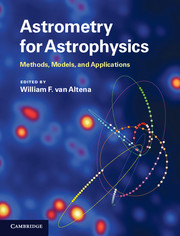Book contents
- Frontmatter
- Contents
- List of contributors
- List of acronyms
- Preface
- Part I Astrometry in the twenty-first century
- Part II Foundations of astrometry and celestial mechanics
- Part III Observing through the atmosphere
- Part IV From detected photons to the celestial sphere
- 13 Geometrical optics and astrometry
- 14 CCD imaging detectors
- 15 Using CCDs in the time-delay integration mode
- 16 Statistical astrometry
- 17 Analyzing poorly sampled images: HST imaging astrometry
- 18 Image deconvolution
- 19 From measures to celestial coordinates
- 20 Astrometric catalogs: concept, history, and necessity
- 21 Trigonometric parallaxes
- Part V Applications of astrometry to topics in astrophysics
- Index
- References
13 - Geometrical optics and astrometry
from Part IV - From detected photons to the celestial sphere
Published online by Cambridge University Press: 05 December 2012
- Frontmatter
- Contents
- List of contributors
- List of acronyms
- Preface
- Part I Astrometry in the twenty-first century
- Part II Foundations of astrometry and celestial mechanics
- Part III Observing through the atmosphere
- Part IV From detected photons to the celestial sphere
- 13 Geometrical optics and astrometry
- 14 CCD imaging detectors
- 15 Using CCDs in the time-delay integration mode
- 16 Statistical astrometry
- 17 Analyzing poorly sampled images: HST imaging astrometry
- 18 Image deconvolution
- 19 From measures to celestial coordinates
- 20 Astrometric catalogs: concept, history, and necessity
- 21 Trigonometric parallaxes
- Part V Applications of astrometry to topics in astrophysics
- Index
- References
Summary
Introduction
As is evident from the preceding chapters, the field of astrometry requires the precise positions of stars and other celestial objects relative to one another within a chosen reference frame. In the old days, images of celestial objects were recorded on photographic plates affixed in the focal planes of telescopes, often long-focus refractors, with image positions subsequently determined with plate-measuring machines. In recent years, practically all image recording has been done with CCD and CMOS electronic detectors (see Chapter 14) instead of photographic plates, with positions determined by computer analysis and sophisticated software.
Whatever the recording medium, the telescope is an instrument to transform the positions of objects on the sky to recorded images on the detector. That is, the telescope is simply a device to gather light and image distant object space on to the detector in the telescope focal surface. This re-imaging process is usually not perfect because of aberrations associated with the telescope. In this chapter we consider the types of optical aberrations and their effects on astrometric analyses.
For the purposes of astrometry the transformation from object space to image space should be done without distortion, though in practice this is rarely the case. By definition, transformation without distortion means that the pattern of multiple objects recorded in image space is identical and in one-to-one correspondence with the pattern of these objects on the sky. Throughout this chapter the term distortion will refer to optical field-angle distortion, or OFAD.
- Type
- Chapter
- Information
- Astrometry for AstrophysicsMethods, Models, and Applications, pp. 201 - 221Publisher: Cambridge University PressPrint publication year: 2012



